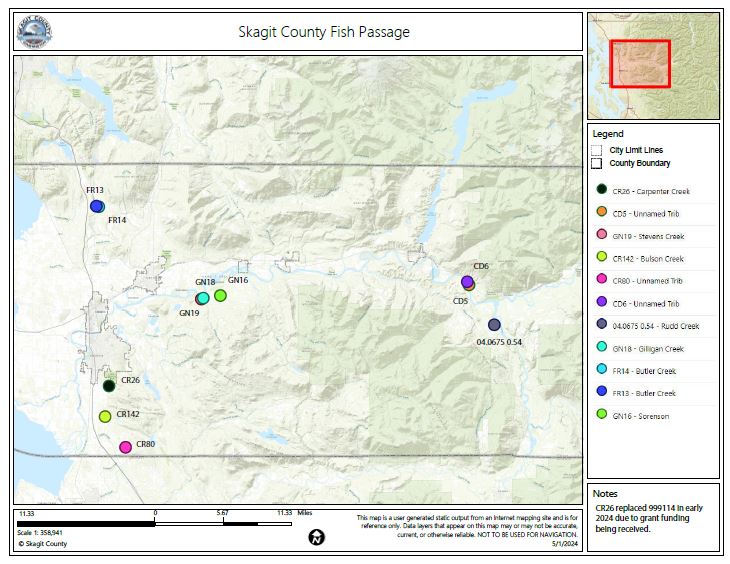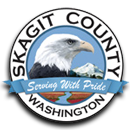Clean Water Program
Public Works
Skagit County Fish Passage ImprovementOne of the most significant barriers to restoring salmonid populations is blocked access to habitat upstream (Shear and Steel, 2006). Many culverts are in a degraded state, undersized, or installed in such a manner that aquatic species, including federally threatened Chinook Salmon and Steelhead Trout, Coho, Pink, Chum, and Sockeye Salmon, resident trout, and many other species, cannot access habitat upstream. In some cases, these culverts can block miles of suitable rearing or spawning habitat. There are many grant funding sources that focus on culvert replacements but they are nationally or regionally competitive, requiring a substantial amount of effort to write grant proposals. Design is funded less often than construction because the benefits aren’t as acutely known. Note, there are many resources available to private property owners (see Skagit Fisheries under More Information). |
||||||||||||||||||||||||||||||||||||||||||||||||||||||||||||||||||||||||||||||||||||||||||||||||||||||||||||||||||||||||||||||||||||
 |
||||||||||||||||||||||||||||||||||||||||||||||||||||||||||||||||||||||||||||||||||||||||||||||||||||||||||||||||||||||||||||||||||||
Identification and Optimization ProcessAs a group, we assessed over 1,000 culverts to determine barrier status. In June 2020, SRSC published a report detailing findings from the assessment work completed by USIT, SFEG, and the County. The full report can be found online here. This report made no effort to prioritize culvert replacement as each organization as their own charge, but it did provide an up-to-date list of known barriers, why they are barriers, how much habitat they block, the current condition of the culvert, and other features helpful in determining a replacement order. There were some limitations to the completion of this report. Most notably, the report did not include the Samish watershed, the Skagit estuary, Fidalgo Island and upstream of the Gorge Dam at Newhalem due to some complicating factors in those areas. Work is ongoing to evaluate culverts in those sectors and the report will be updated over time with this information and updated culvert assessments within the original geographic area. DesignSkagit County quickly became aware that working through the standard grant process would take an unacceptable amount of time to complete restoration of our key culverts. The County reached out to the legislature to request $1 million to fund design of key culverts within the County. The County will be providing matching dollars to complete a total of 11 culvert designs by December 2025. The intent is that these designs will be more competitive for construction grant funding, allowing replacement on a much shorter timeline. |
||||||||||||||||||||||||||||||||||||||||||||||||||||||||||||||||||||||||||||||||||||||||||||||||||||||||||||||||||||||||||||||||||||
 Enlarge map |
||||||||||||||||||||||||||||||||||||||||||||||||||||||||||||||||||||||||||||||||||||||||||||||||||||||||||||||||||||||||||||||||||||
PI - The Priority Index (PI) is a number calculated by the Washington State Department of Fish and Wildlife (WDFW) for each culvert using a modified version of its formula. The PI equation uses six modifiers for each fish species within the stream reach of interest. The WDFW uses PI values to prioritize county road crossings for future fish passage barrier correction. The higher the number the larger the benefit. PI requires physically walking each stream to its headwaters. This work is ongoing. |
||||||||||||||||||||||||||||||||||||||||||||||||||||||||||||||||||||||||||||||||||||||||||||||||||||||||||||||||||||||||||||||||||||
|





